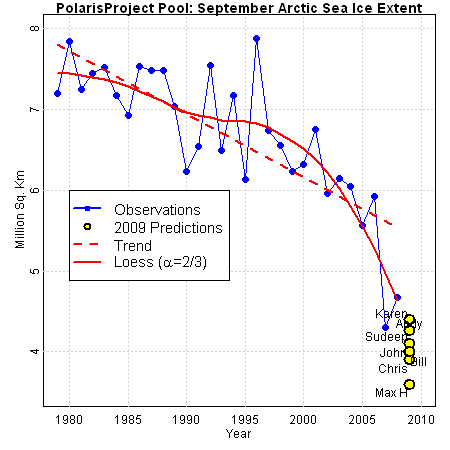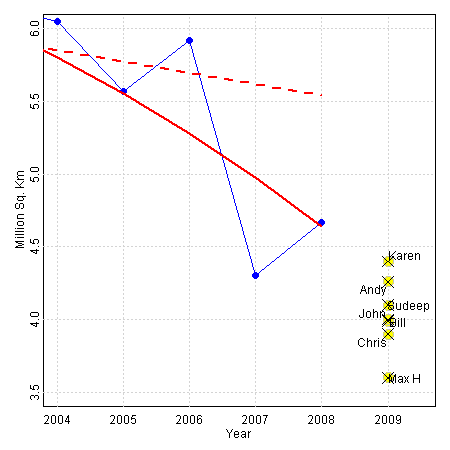Some of the folks here at Polaris headquarters are betting on the minimum extent of arctic sea ice in 2009. We did this last year and then wrote about it again this year. We are not alone. Look here, here, and here. All Polaris folks are welcome to compete for the grand prize – being toted about during next year’s field course in a sedan chair (legal disclaimer – there is no prize except undying glory).
I’m actually very interested in this question and it touches on a great deal of the science we study in the Arctic. Most importantly, the question of whether the dramatic melt of 2007 and 2008 is the result of a forcing or a feedback is critical. It’s well known that the models of sea ice melt are more conservative than the actual melt. So, if the greater than expected melt is the result of a forcing it means that the forcings are wrong (not accounting for say, black carbon on the surface). If the melt is a result of a feedback (say, bottom-up ablation) then we need to be on the look out for a greater than expected and sooner than expected invocation of the ice-albedo feedback. Either way, the models are wrong (The great statistician George Box famously wrote that ‘…all models are wrong, but some are useful.’). Work by Julienne Stroeve and others have documented this well. E.g., here. I think Mark Serreze made a good case that 2007 melt record was in large part due to really good weather conditions for melting ice. in fact he has a very nice article on sea ice changes both in Nature from last year and an article in a newsletter from ARCUS called: Arctic Climate Change: Where Reality Exceeds Expectations. Look here. I especially like the Serreze is an inherently skeptical scientist.
But I digress….Putting these bets together is a good excuse to be thinking about this issue. Here are the bets for this year:
And a zoom to see the detail:
Max continues his doomsday ways from last year but several of us are predicting new record lows. I continued my stat geekery but using a loess filter this year to make my guess. There is a lot of data out there to help making the forecast. I think the introduction of a possible El Nino this year and the warm water in the Bering Sea (here to compare 2008) are favorable to big melt but I’m sticking with a melt close to the 2007 level. You can click here to get the latest measurements from NSIDC or a report from ARCUS here.
Regardless of all our pontificating, the game is afoot!
-Andy Bunn






Comment(1)-
max says
July 4, 2009 at 2:17 amThe ARCUS (Arctic Research Consortium of the United States) report that Andy refers to above is the Sea Ice Outlook Report, which is coordinated by the SEARCH (Study of Environmental Arctic Change) Science Steering Committee. As a member of that committee, I can report that there was actually a lot of discussion and disagreement about whether SEARCH should undertake this endeavor. I was in favor of doing so, but some of the reluctance by others was related to concern that we didn’t know enough to make good predictions of future Arctic ice conditions and therefore risked looking foolish. My view is that publicly making “predictions” will help us to sharpen our understanding of Arctic change – and besides, I’m used to looking foolish!